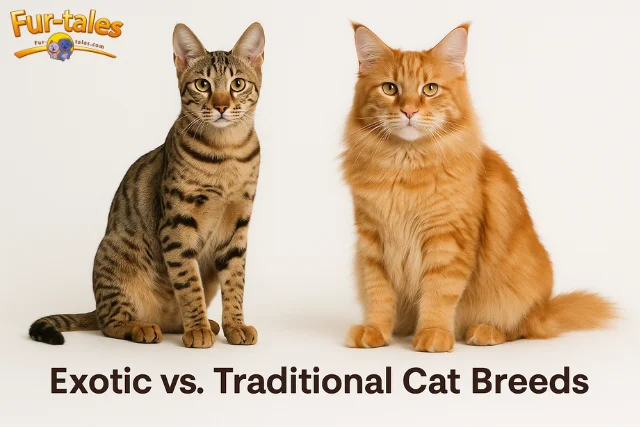
Exotic vs. Traditional Cat Breeds: What’s the Difference?
Bringing a new feline friend into your life is one of the most exciting decisions a pet lover can make. But choosing between exotic and traditional cat breeds can be a little confusing—especially if you’re a first-time cat parent. Whether you’ve got your eye on a snuggly Persian or an elegant Savannah, understanding the key differences between these types of breeds can make your choice easier and more informed.
Let’s break it down together, with practical tips, real talk, and helpful insights—just like a chat with a fellow cat enthusiast at your local pet café.
🐾 What Do “Exotic” and “Traditional” Cat Breeds Actually Mean?
Before we compare the personalities, health, and care requirements of these feline categories, it helps to define them clearly.
- Traditional Cat Breeds are those we’ve known and loved for generations. Think American Shorthairs, Maine Coons, Siamese, and Persians. They’ve been around for decades—some for centuries—and are widely recognized by major cat registries like CFA and TICA.
- Exotic Cat Breeds refer to either:
- Breeds with wild ancestry (like Bengals or Savannahs).
- Rare, newly developed breeds (like the Lykoi or Peterbald).
These cats are often bred for unique physical traits or to mirror wildcat aesthetics while maintaining a domestic temperament.
🧬 Origins and Breeding
Traditional Breeds:
Traditional breeds have long, documented histories. Breeders focus on preserving bloodlines, standard appearances, and consistent temperaments. For example:
- Siamese cats were once temple guardians in Thailand.
- Persians have been adored for their luxurious coats since the 1600s.
These breeds have been refined over generations and are well-documented in registries.
Exotic Breeds:
Exotic breeds are often the result of selective or cross-species breeding. For instance:
- Bengals are a mix between Asian leopard cats and domestic cats.
- Savannahs combine the genes of African servals and domestic cats.
Because of their wild heritage, many exotic cats have only been domesticated for a few generations—meaning their temperaments can be more unpredictable.
😸 Temperament and Behavior
Traditional Cats:
In general, traditional breeds tend to have stable, well-understood personalities. They’re known for being affectionate, trainable, and adaptable.
- Ragdolls are famously floppy and relaxed.
- American Shorthairs are great with kids and make excellent lap cats.
- Maine Coons are dog-like in their friendliness.
These cats are ideal for first-time pet parents looking for predictability.
Exotic Cats:
Expect a mix of playfulness, independence, and sometimes wild behavior.
- Savannahs are intelligent, curious, and love water.
- Bengals need a lot of stimulation and aren’t ideal for quiet homes.
- Chausies can jump incredible heights and love interactive play.
Exotics are better suited for experienced cat owners or those ready to meet high-energy needs.
🩺 Health and Veterinary Considerations
Traditional Cat Breeds:
Their long breeding history means many traditional breeds come with known health risks, but they also benefit from established care routines.
Common issues include:
- Persians: Prone to breathing issues (due to flat faces) and kidney disease.
- Siamese: May develop dental or respiratory problems.
Still, your first vet visit guide will include typical vaccinations, spaying/neutering, and a basic pet health checklist for screenings and diet recommendations.
Exotic Cat Breeds:
Health care can be trickier here. Their wild ancestry means:
- Vaccination responses may vary.
- Some exotics aren’t fully accepted by all veterinarians (especially hybrid breeds like Savannahs).
- Specialized diets and behavior assessments may be needed.
For instance, Savannahs often require taurine-rich diets and large spaces to thrive. Before adopting, check with your vet to confirm they’re familiar with the breed’s needs.
👉 New pet owner tip: Always research your breed’s specific medical needs and talk to a vet who has experience with exotics if you’re leaning in that direction.
🛁 Grooming and Maintenance
Traditional Cats:
Many traditional breeds have moderate grooming needs:
- Short-haired cats like the British Shorthair need weekly brushing.
- Long-haired breeds like Persians or Himalayans require daily grooming to avoid matting and hairballs.
They’re usually tolerant of being groomed and benefit from a regular routine.
Exotic Cats:
Grooming can range from minimal to meticulous:
- Sphynx cats (a hairless exotic) need weekly baths to remove skin oils.
- Bengals and Savannahs have short coats but may enjoy water-based play, which can make cleaning easier (or more chaotic!).
👉 New pet owner tip: Invest in breed-specific grooming tools and consult your vet or groomer for care tips during your first few weeks together.
🏡 Ideal Home Environments
Traditional Cats:
They adapt well to a variety of living situations:
- Apartments ✔️
- Families with kids ✔️
- Quiet, low-stimulation environments ✔️
If you’re a work-from-home parent or want a relaxed companion, traditional breeds are perfect.
Exotic Cats:
These cats often require:
- Larger spaces or vertical climbing options.
- Outdoor enclosures (aka “catios”) for safe stimulation.
- Highly interactive toys and mental challenges.
Exotics may not suit homes with young children or elderly residents unless managed carefully.
💸 Cost and Availability
Traditional Breeds:
Easier to find through reputable breeders or shelters. Adoption fees typically range from $100–$1,200 depending on the breed and lineage.
Exotic Breeds:
Prepare for higher price tags—often $2,000 to $20,000—especially for F1 (first generation) hybrids like Savannahs. They also may require special licenses or adherence to local laws, particularly in states like California or New York.
👉 New pet owner tip: Always choose a breeder registered with associations like CFA or TICA and request health guarantees.
✔️ Which Should You Choose?
Here’s a quick breakdown:
| Feature | Traditional Breeds | Exotic Breeds |
|---|---|---|
| Temperament | Predictable, affectionate | High-energy, independent |
| Grooming Needs | Moderate to high | Varies (low to specialized) |
| Health Considerations | Well-documented | May require specialist care |
| Home Environment | Adaptable | Needs stimulation/space |
| Ideal For | New pet owners, families | Experienced owners |
If you’re looking for a cuddly, calm companion, go traditional. Want an active, wild-looking cat with flair? Exotic might be your match—but be prepared to go the extra mile.
FAQs: Exotic vs. Traditional Cat Breeds
Q: Are exotic cat breeds legal in all U.S. states?
Not always. States like Hawaii and California ban certain hybrid breeds like Savannahs. Always check local regulations before adopting.
Q: Are exotic cats dangerous?
Most are domesticated enough to live safely in homes, but their energy levels and instincts can be overwhelming for new owners.
Q: Can I find exotic breeds in shelters?
It’s rare, but it happens. Specialty rescues sometimes take in Bengals or other hybrids, especially if their owners were unprepared for their needs.
Q: Do exotic cats get along with other pets?
It depends on the breed and socialization. Bengals and Savannahs may coexist with dogs but might dominate smaller pets.
Q: How can I prepare for my first vet visit with an exotic cat?
Bring breed-specific medical notes, ask if the vet has hybrid experience, and ensure vaccinations and diet plans are tailored to their unique physiology.
Image Designed Using Canva
